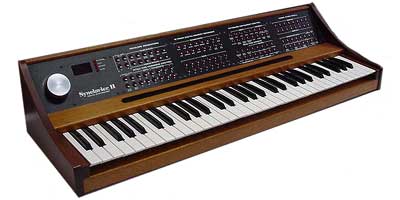


The '''Synclavier Digital Audio System''' manufactured by New England Digital was a powerful, fully integrated computerised audio system used for music and post production. Using it's combination of synthesis, sampling, disk recording, and it's comprehensive proprietory software and hardware it was not only a powerful music performance and compositional tool but also a very accomplished sound design and editing system. It was first developed in the late '70s at Dartmouth College by Jon Appleton, Sydney Alonso and Cameron Jones.
Probably once as famous for it's cost as much as for it's musical abilities - full blown late systems would retail for between $200,000 - $300,00 US. The largest system built and sold by NED selling for $500,000. Instantantly recognisable with it's unique keyboard. The image on the left is the ORK (ORiginal Keyboard) and on the right is the later V/PK (Velocity/Pressure Keyboard)
Early Years
In 1972 Cameron Jones and Sydney Alonso met after being offered a summer job at Dartmouth College programming the large time-sharing computer. Together they developed software and hardware that let the computer make 'beeps and whistles' which could be used to produce electronic music and aid students in ear-training under the guidance of Jon Appleton.
Over the next four years they honed their music synthesizer, managing to graduate in this time as well. In 1975 Cameron and Sydney developed a 16-bit processor card, and modified the Data General XPL compiler for their new processor. This 'ABLE' computer became New England Digital's first product. Mainly sold for academic data-collection applications, freeing up the need to book time on large main-frame systems.
This was followed by a commercial version of their 'Dartmouth Digital Synthesizer' based around the ABLE miniprocessor, the Synclavier® (pronounced sin-cla-veer by the inventors). In 1979 after raising a little capital, the pair produced the Synclavier II. Brad Naples, graduate of Harvard University, joined the team - bringing with him his business experience and acumen - after seeing the Synclavier® being demonstrated on local TV and realising it's commercial potential.
Synclavier II®
It was the Synclavier II that brought the system to the public attention in the early '80s.
Starting life as an 8-bit Frequency Modulation synthesis / Additive synthesis synthesiser with a '32 Track Memory Recorder' and the famous wooden keyboard - early models were controlled entirely by the keyboard buttons and silver control wheel. Shortly afterwards models would have a VT100 terminal display and keyboard, enabling software additions over and above those performed on the keyboard. Being a modular system, each new upgrade could be retro-fitted into even the earliest machines.
Being only 8-bit gave the FM / Additive synthesis system a warmth and 'human' quality to the sound. Yamaha would later adopt a 16-bit version based on the Synclavier system in their DX7 keyboard, which unlike the Synclavier was notoriously difficult to program and had a harsher, digital sound.
An energetic phase of hardware developments and software upgrades were embarked upon as a result of the success of the Synclavier II, most notably with the addition of 'sampled' sound recording and playback capablities. At the time (1982-3) RAM was extremely expensive and because of this competing samplers were forced to use 8-bit sampling. NED designed the '''Sample-To-Disk''' option (the first commercial hard disk recording system) to allow for 16-bit sampling at up to 50Khz.
Because drives were slow at this time, only mono playback of samples was possible but these could be mixed with FM sounds and multiple samples could be layered and patched across the keyboard.
A VT640 graphics terminal was added to enable onscreen graphics with which to perform analysis and editing of sounds in the frequency domain using a program known as '''Signal File Manager'''. This now allowed NED to include Additive Resynthesis (a sampled sound could be recreated frame by frame in FM allowing limitless possibilty of sound creation) and complex audio analysis software. Early machines were also purchased by audio research institutes for their scientific capabilities.
Other additions added were SMPTE time code tracking (incredibly the Synclavier tracked SMPTE time code in varispeed. if the tape speed slewed or slowed down, so did the Synclavier sequence, adjusting sound duration to match) and reluctantly, as they felt it was non professional when first released, a MIDI interface.
Synclavier PSMT®
The limits of mono sampling soon became apparent, so a complete new subsystem for polyphonic, 16-bit RAM based stereo sampling was developed along with a faster ABLE 'Model C' processor to cope with the extra workload. As the original FM system was mono, NED upgraded this to stereo to be compatible with the stereo sampling by doubling up on the mono FM voice cards and enabling dynamic panning in software.
The original keyboard, the 'ORK', had no velocity and after-pressure so the famous 'VPK' keyboard was introduced. Finished in black piano laqueur and sporting a larger display, a 6 octave spread, the feel of a real piano to it, a wealth of extra buttons and the trademark silver control wheel. This keyboard now reflected the quality of the system in appearance as well as the ever escalating costs of the hardware.
Along with a new 'Multi-Channel Distribition' system (real-time, digitally controlled, analogue signal routing) the '''Synclavier PSMT''' was born. Boasting a phenomenal spec. for 1984 (and even by todays standards) the system had now become a true self-contained digital workstation.
See also What makes the Synclavier so special? for history of later systems and the philosophy behind the design
© 2000, 2001, 2002, 2003, 2004, 2005, 2006 Synclavier European Services. All Rights Reserved. Synclavier™ is the proprietary trade mark of Cameron W. Jones

